Question and Answer – June 2011
If you’d like Neil’s help with a plant question, send it to him along with a photo. He will select those of greatest reader interest, so no plant IDs, please. Remember that Neil requires photos for all questions that are used in e-gardens – be sure you attach one. Click to send your question and photo.
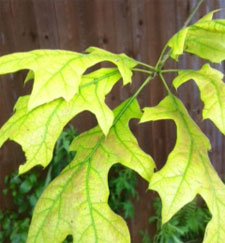
Question: I planted this red oak about 12 years ago. The past few years, it has had yellow leaves and dark green veins. I have applied iron, both granulated and chelated, but with no results. How can I help my tree? N.H., Plano.
Answer: This is the most common question I get on red oaks, and I never make the reader or listener very happy with my reply. Click here to see how I have answered it on my website. Due to the number of years you have had your tree, I do not believe that it’s trunk damage. In my opinion, you don’t have a true Shumard red oak – the one that is adapted to the alkaline black clay soil of DFW. Somebody sold you a pin oak or some type of hybrid that requires acidic soils. Look around as you drive through Plano and the rest of Collin County, and you’ll see dozens of other trees that look just like yours. I could probably direct you to 200 of them. Now for the difficult part of my message: trying to correct this by additions/injections of iron is just going to prolong the agony. It will get more and more expensive to try to cope with the iron deficiency issues as the tree grows larger. I have never seen it work in my 41 years of living in DFW. Not with pin oaks, water oaks, willow oaks, sweet gums, bald cypress, silver maples or slash or loblolly pines. When they start turning yellow, it’s a one-way trip. I so want to help, but there just isn’t any remedy short of replacing the tree. I am so sorry to be the messenger of that information. Good luck!
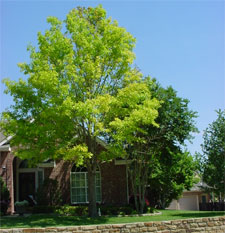
Question: I’ve been told that pin oaks don’t grow well in Texas, but I didn’t know why. After much research on the Internet, I’ve decided that my tree needs iron. I punched 10 one-inch holes around the tree’s drip line and have made several applications of liquid iron. Am I wasting my money? P.K., McKinney.
Answer: This is the same issue that we addressed in the first question just above. I’m not sure whether you saw the page on my website. As I mentioned, it’s the most-asked question I get about oaks. You can see a dozen or more examples on Eldorado Parkway in McKinney, on the south side of Eldorado, a couple of blocks west of Lake Forest Drive.

Question: I have an unusual looking insect on my hollies and esperanzas. What is it, and what will control it? L.McM., Springtown.
Answer: It’s a leaf-footed bug. Click here to see a Texas A&M photo for comparison. Independent retail nurseries will offer several insecticides for its control. Note that true "bugs" such as stink bugs, squash bugs and boxelder bugs are fairly resistant to treatments. Stay on top of the problem.
Question: I have two spots on this 3-year-old peach tree that are concerning to me. The upper one killed a branch, and the other is at the base of the tree. Will they heal? J.S., Kerens.
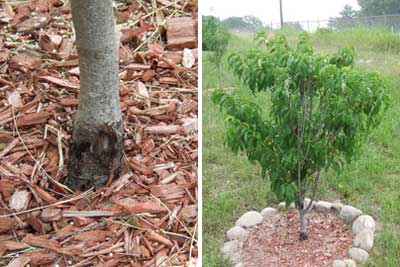
Answer: It looks like the injury at the base is trying to heal. Remove the dead branch and see if new bark will form across that wound as well. There isn’t much else you can do at this point other than wait. Time will tell.
Question: I need help identifying and controlling this weed in my lawn. I thought it might be crabgrass, but 2,4-D did nothing to control it. What can I do? C., Little Elm.
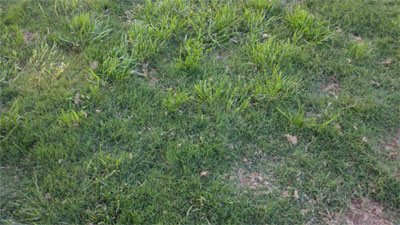
Answer: It’s not crabgrass. It looks like a winter grass that has gotten into your lawn over the dormant season. Hopefully it will run its course soon. Mow your bermuda short (1-1/2 inches) and frequently to help the summer’s heat kill the weed out. We have no weedkiller that will stop it, certainly not 2,4-D. 2,4-D is intended solely for non-grassy (broadleafed) weeds. I would also suggest application of a pre-emergent in the first week of September to keep any additional seeds of this grass from sprouting.
Question: I am having trouble with this evergreen. They had bagworms last year, and now they are struggling. One is already dead, and one has lots of brown branches. What has happened? K.D., no city given.
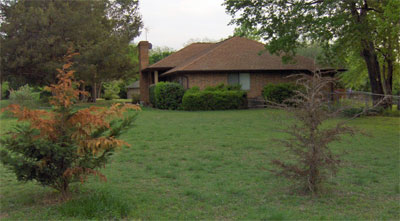
Answer: These are Leyland cypress, and they have been hit by a fungal disease that has become all too common. Click here to see a report from Auburn University. I suspect that this is the same disease that is attacking Blue Point and several other junipers. It may very well be that the bagworms served as the vectors in its spread.
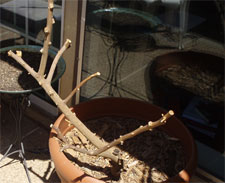
Question: We brought our potted Meyer lemon that we salvaged after Hurricane Katrina. It struggled with the winters, but it always survived. Please settle a dispute between my husband and me. Is there any chance it will come back, or should I salvage the pot? A.H., Grapevine.
Answer: We’re far enough into the growing season that it should have sprouted out if it were ever going to do so. My vote is to salvage the pot and move on. These really can’t stand sub-freezing weather. Sorry.
Question: I lost seven hollies last spring. I have long since removed them, so I don’t have a photo of the plants. However, a local nursery suggested I send a soil test sample to Texas A&M. I’ve attached that report. I went back to the nursery, and they told me that your 24-0-0 fertilizer wouldn’t be good enough. I’m confused. I want to replant, but I don’t want to waste my money. What should I do? L. O’D. Fort Worth.
Answer: Let me start with what sure facts we can assemble. Fact 1: as noted, your seven hollies died. Fact 2: the soil tests show that the only nutrient needed is nitrogen, so the 24-0-0 would be perfect. My assumptions: I can add to that my very sincere opinion that there has never been a holly that died within the first year of its life due to a shortage of nitrogen. I can also add, from my own life’s experiences, that 99 percent of the hollies that die in their first year have simply gotten too dry at one time or another. Hollies do not wilt visibly, so it’s very, very easy for them to get too dry before we notice any problem. I lose one or two new plants every year simply by my own carelessness. I’ve never seen insects or diseases bother hollies early on. Adapted hollies are some of our finest landscape shrubs. If you made a good choice of holly variety in the first place, it would be a fine replacement. You just need to make a commitment to hand-water the plants every three days for their first summer.
Question: What should I do with my Silverado sage? It is five years old. The first three years, it grew well. The past two winters have hurt it. No name given, Altoga (Collin County).
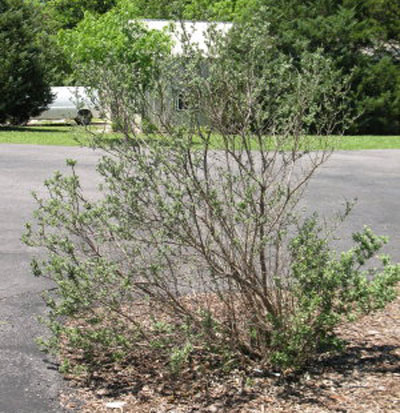
Answer: This is winter damage, so your analysis is correct. Trim it back severely – probably 75 percent or more. See if it offers to regrow. You may have to replace it. They were hurt badly all over North Texas this winter.
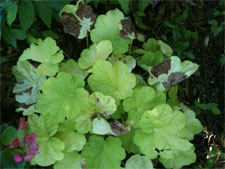
Question: My coral bells Heuchera ‘Tiramisu’ came through the winter just fine, but it has developed these browned spots early this spring. What is it, and what can I do about it? K., University Park.
Answer: Good question. It looks like iron deficiency, due to the pale leaf color, the darker green veins and the fact that it seems to be worse on the newer leaves. Iron deficiency can end up causing browned, dead tissues and dead plants. These could be fungal leaf spots, but you would need to be able to see black spores within the spots if that were the case. I would try adding an iron/sulfur material. Keep it off masonry surfaces to avoid staining. I have not grown ‘Tiramisu’ coral bells, but the online photos I see show there should be a lot more reddish shading in the leaves. I’d also suggest an application of nitrogen if you’ve not done so already.
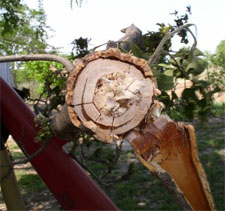
Question: I’ve had tree girdlers in my trees before, but this seems to be a pest that started eating from the middle out. I’m curious what caused this. J.R.N., Stoney (Denton County).
Answer: Give yourself more credit for your analysis. This is twig girdler. The female laid her eggs on the fallen portion after she cut around and around the twig with her mouthparts. You’ll notice that the middle portion broke off in a jagged manner. The insect never cut into it. Rake any branches that look like this, and either burn them or send them to the landfill. That won’t prevent future twig girdler damage, but it will at least get rid of the ones in the fallen twigs. No spray will help with this pest.


